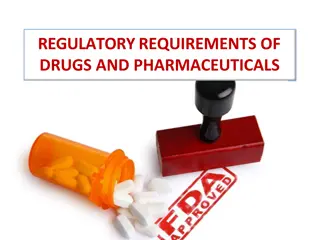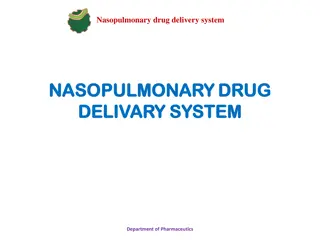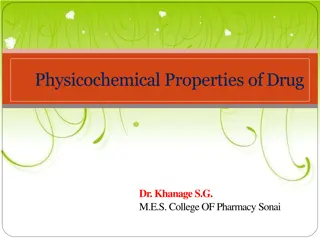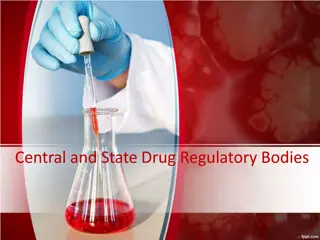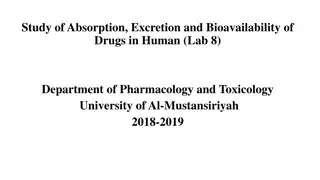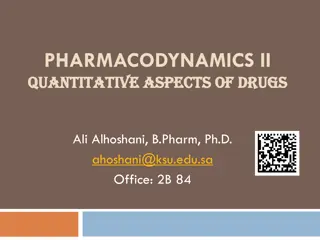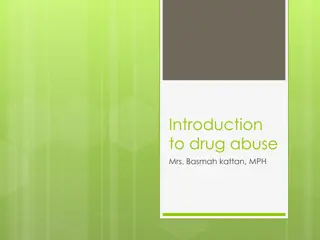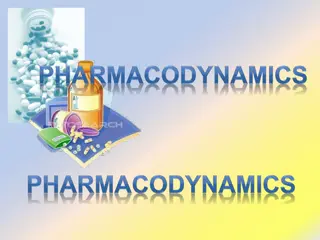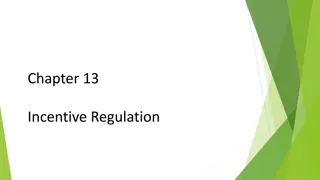Drug Regulation Agencies and Functions in India
Drug regulation in India involves various agencies like CDSCO, ICMR, and NPPA to ensure the safety, efficacy, and quality of pharmaceutical drugs. Activities include product registration, quality control, and monitoring adverse drug reactions to protect public health.
Download Presentation

Please find below an Image/Link to download the presentation.
The content on the website is provided AS IS for your information and personal use only. It may not be sold, licensed, or shared on other websites without obtaining consent from the author. Download presentation by click this link. If you encounter any issues during the download, it is possible that the publisher has removed the file from their server.
E N D
Presentation Transcript
Meaning Introduction Keyfunction Agencies in INDIA Agencies in US Agencies in JAPAN Agencies in EU ICH References
Drug All medicines for internal or external use of human beings or animals and all substances intended to be used for diagnosis, treatment, mitigation or prevention of any disease or disorder in human beings or animals. Regulation To regulate means to control something so that it functions properly .
Drugs play important role in the health and economy ofa country. Pharmaceutical drugs are available from number of source. To ensure that that they meet prescribed standards. To ensure the safety, efficacy and quality of drugs as well as accuracy and appropriateness of the drug information available to the public.
Product registration. Regulation of drug manufacturing, importation , and distribution. Adverse drug reaction monitoring. Licensing of premises & persons &practices. Main goal of the agency is to guarantee the safety , efficacy, and quality of the available drug product .
QUALITY CONTROL DRUG DRUGS LAWS . INFORMATION CENTER DRUG REGULATION DRUG DRUG REGULATORY BOARDS REGULATORY AGENCY
Central Drug Standard Control Organization (CDSCO) Ministry Of Health & Family Welfare (MHFW) Indian Council Of Medical Research(ICMR) Indian Pharmaceutical Association(IPA) Drug Technical Advisory Board(DTAB) Central Drug Testing Laboratory(CDTL) Indian Pharmacopoeia Commission(IPC) National Pharmaceutical Pricing Authority(NPPA)
To approve license to the various manufacturing of certain categories of drug as central licensing approving authorities i.e. For Blood Banks, Large Volume Parental And Vaccines And Sera. To regulate the standards of the imported drug products. Work Relating ToThe Drug TechnicalAdvisory Board (DTAB) And Drugs Consultative Committee. Testing Of Drugs By Central DrugsLab. Publication Of The Indian Pharmacopeia.
MAIN BODIES The Food And Drug Administration (FDA). National Institute Of Health (NIH). Centers For Disease Control And Prevention . Department Of Health And Human Service(DHHS). FedWorld Us Information . National Center For Complementary And Alternative Medicine (NCCAM).
The Food and Drug Modernization Actstates that the FDA has 4roles: To promote health by reviewing research and approving new products. To ensure foods and drugs are safe and properlylabeled. To work with other nations to reduce the burdenof regulation . To cooperate with scientific experts and consumers to effectively carry out theseobligations.
The Office of the Commissioner (OC) The Center for Drug Evaluation and Research (CDER) Centerfor tobacco product The Center for Biologics Evaluationand Research (CBER) The Office of Regulatory Affairs (ORA) FDA The Center for Food Safety and Applied Nutrition (CFSAN) The National Center for Toxological Research(NCTR) The Center for Veterinary Medicine (CVM) The Centerfor Devices and Radiological Health (CDRH)
Protecting the public health by Assuring that thefood products are safe. Assuring human and veterinary drugs, andvaccines and other biological products and medical devices intendedfor human use are safe andeffective. Protecting the public from electronic productradiation. Assuring cosmetics and dietary supplements are safeand properly labeled. Advancing the public health by helping to speedproduct innovations. Helping the public get the accurate science-based information they need to use medicines, devices, andfoods to improve their health.
MAIN BODIES: Ministry of Health and Welfare National Institute of Infectious Diseases National Institute of Health Sciences
In January 1938, the Ministry of Health and Welfare was established by integrating the administrations of the Sanitary Bureau and the Social Affairs Bureau in the Ministry of Home Affairs. In September 1947 The Ministry of Labour was established by integrating labour administrations that had previously been conducted by the Ministry of Health and Welfare.
Social insurance aagg ee nnccyy MHLW Ministry proper HHeeaalltt hh aann dd wweellffaarree bbuu rr eeaauu ffoorreellddeerrllyy Minister s secretariat Equal employment children & family bureau Heath policy bureau Heath service bureau Insurance bureau PFSB Pension bureau Social welfare & war victim s relief bureau Director general for policy planning 17
Social Welfare : Services for elderly people Services for persons with disabilities Social Security : Pension systems that will ensure income in elderlyage Long term insurance to provide nursing careservices Public assistance systems that guarantee minimum standards.
Job Security : Public Hygiene : Appropriate medical services for diseases &injuries Ensuring the safety of food, Water and medicalsupplies Research into health science in order to make technological advances Maternal and child health Promotion of employment Employment ofelderly people Employment ofpersons with disabilities Management of the employment insurance system
MAIN BODIES: EU Legislation - Eudralex European Directorate for the Quality of Medicines and Healthcare (EDQM) European Medicines Agency (EMEA) Heads of Medicines Agencies (HMA)
The EDQM (Council of Europe) is a key European Organisation involved in Harmonisation & Co-ordination of Standardisation, Regulation & Quality Control of Medicines, Blood Transfusion, Organ Transplantation, Pharmaceuticals and Pharmaceutical Care. In 1996 The European Directorate for the Qualityof Medicines (EDQM) is created.
To contribute to the basic human right of access to good quality medicines and healthcare and topromote and protect human and animal healthby: Establishing and providing official standards which apply to the manufacture and quality control of medicines in all signatory States of the "Convention on the Elaboration of a European Pharmacopoeia" and beyond; Ensuring the application of these official standards to substances used in the production ofmedicines.
EMA is a European agency for the evaluation ofmedicinal product. EMA was set up in1995. From 1995 to 2004, EMA wasknown as European agency for the evaluation of medicinal product. The European Medicines Agency (EMA) is a decentralized body of the European Union, located in London Mission: to foster scientific excellence in evaluation and supervision of medicines
Provides independent, science-based recommendations on the quality, safety and efficacy ofmedicines. Applies efficient and transparent evaluationprocedures to help bring new medicines to themarket. Implements measures for continuously supervisingthe quality, safety and efficacy of authorisedmedicines. Provides scientific advice to stimulate the development and improve the availability of innovative newmedicines







